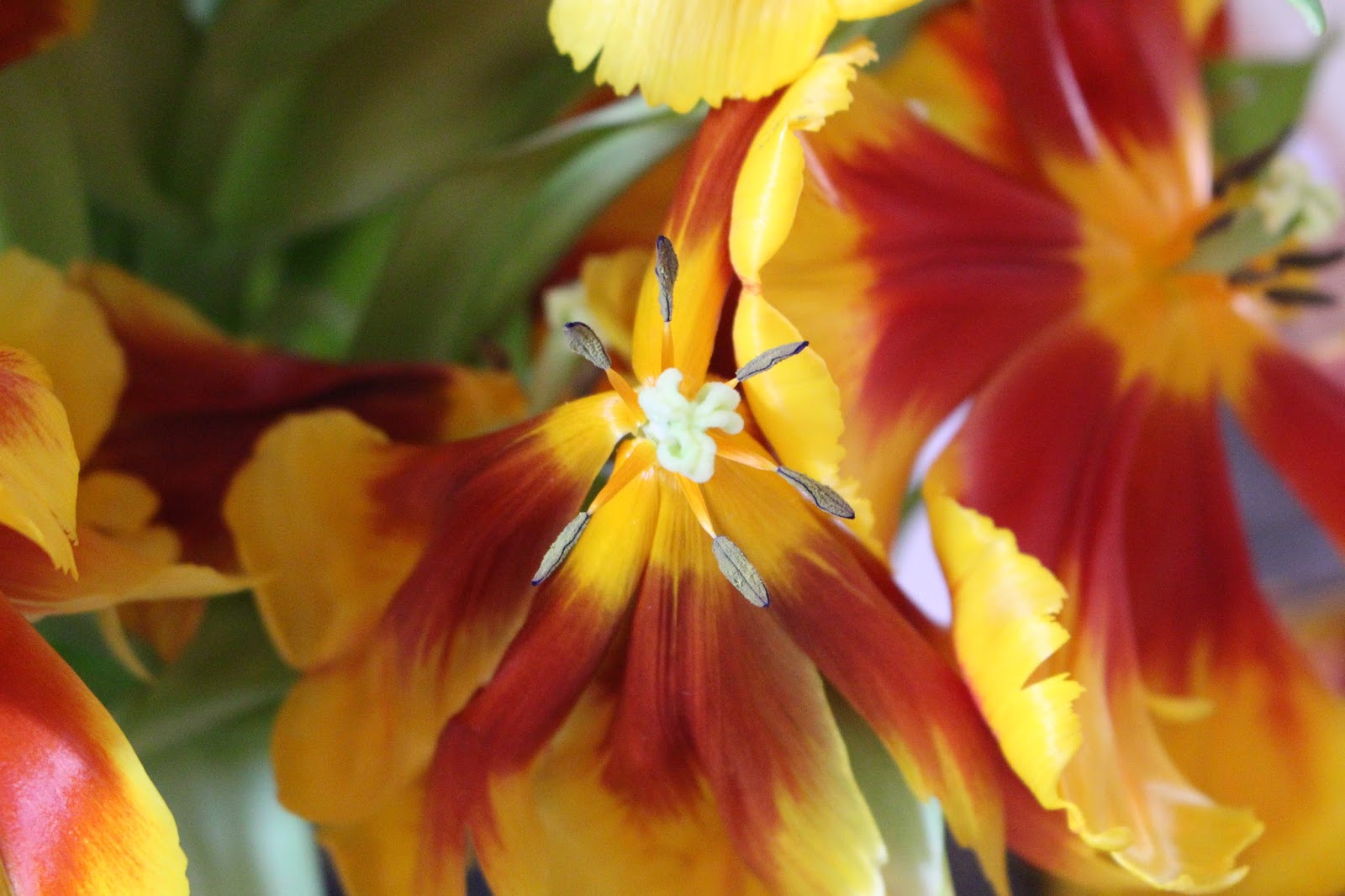Ironically, the first day of spring just has to snow. There was a last minute storm, causing an early dismissal from school. There's about 4-6 inches, and it's pretty heavy-packed snow. Perfect for snowman's and snowball fights, yet it invites itself on the first day of spring! The weather was warm the whole week,(in the 50's), yet the first day just has to snow. Good sign?
Here is an overview of these red-yellow tulips we bought about two-three weeks ago. So the bulbs come in a glass vase, no soil. It's by a company named Bloomaker. They innovate bulbs to just grow off of water and sunlight. The flowers also stay longer than usual and can be replanted in fall time. I though it was pretty cool, especially because the vase was glass, which means you can see the roots, bulbs, and water level. We bought it, and within a few days, it started blooming.
The trick is that you should rotate the vase quarterly or halfway once a week. It's kinda hard to not keep your hands off of the vase and flowers when you look at them. So the vase would keep moving pretty much everyday. Rotating distributes the sunlight evenly to all of the flowers. Touching it every so often a day interrupted the amount of sunlight each flower got. Which eventually caused the tulips to bloom at different times.
This picture actually still really irritates me. Why? You can't see the center of the flowers. It's close, perhaps just an inch away, but you're just not able to see the middle.
Ahh finally, the center. You have a clear view of it. Remember that you should off-center you subject. Now I made my subject all the way on the righ-bottom corner. It makes the viewer to look all over the picture and see all the details, instead of a glance.
In the sea of red-yellow, we have one shy stalk of green. I forgot to mention, these tulips look like they're on fire. The colors, red in the middle coming out to a yellow, resembles a flame almost perfectly. This lonely stalk of green in the middle looks like this lone survivor in a fire.
Now I had a hard time taking pictures of these tulips. I took tons and tons, but I think the major problem was that the lighting wasn't right. I took it in different places, at different angles, with different lightings, but these flowers were a slight challenge. To be fancy, I even tried a mirror. So in this picture, you have the flower on the left, reflecting onto the right hand side. It's hard to tell that it's a reflection from the angle I took it at.
So i've just learned some botany, specially for this picture. I'll teach you the different parts of a tulip. First off, we all know where the petals are. Those are the red-yellow colored "leaves" you see on a flower. In this picture, it is surrounding the middle. The white thick stalk you see shooting straight from the middle of the tulip is called the pistil. The very top of the pistil, the curvy white chunk you see, is called the stigma. The stigma captures the pollen from various sources. The style is the long tube that connects the base (where the eggs are stored) to the stigma.
The stem like structures, surrounding the pistil, are called the stamen. The stamen actually reproduce the pollen and consists of two parts. The very top portion of it is called the anther. This is where pollen gathers and where bees pollinate. The stalk underneath is called the filament. When insects pollinate on the anthers, it shakes off some pollen onto the stigma or other flower's stigma's. Wind can also transfer the pollen as well. The stigma then collects the pollen and germinates. Pretty cool huh? Oh and ironically, the word of the day for March 20th, 2015 on dictionary.com was anthesis. It means, the period or act of expansion in flowers. Fits perfectly!

Now that you know the anatomy of a tulip, we can end the cycle with the wilting of these tulips. These tulips, after two-three weeks, have the weirdest way of dying. I've never seen a single flower like this before. So what happened was that the petals of the tulip bloomed, but it kept extending out and out and out. Until you see it like this and in the picture right above. The petals went past a 180 degree and are now drooping and falling off. Usually, petals just wilt at their highest blooming point, and then it just falls off. Despite it's way of ending it's cycle these flowers were very very pretty to see. Interesting start to spring!








No comments:
Post a Comment